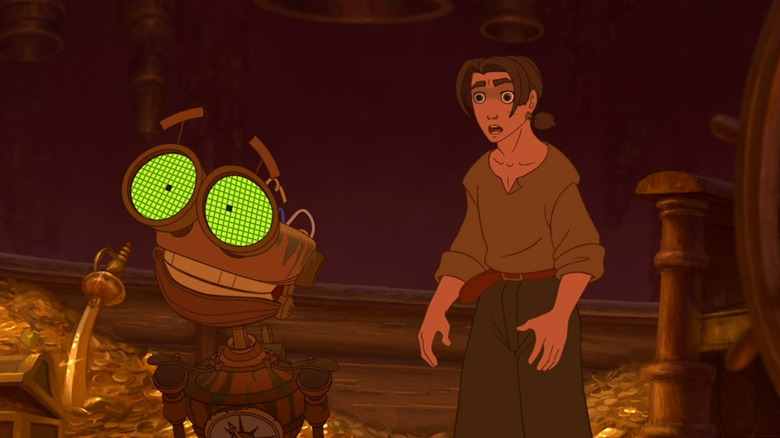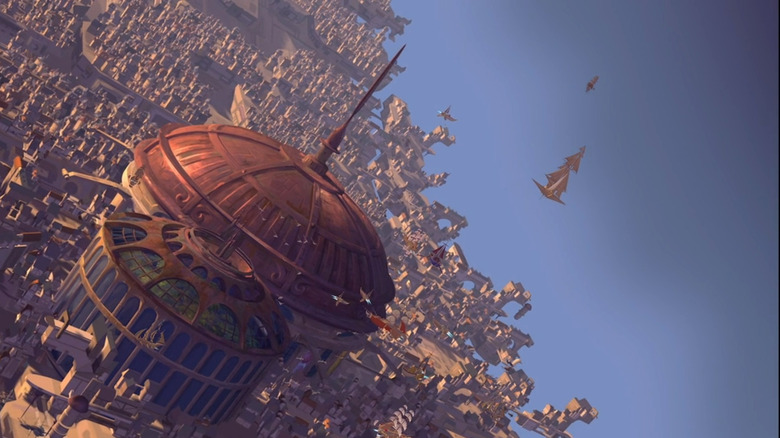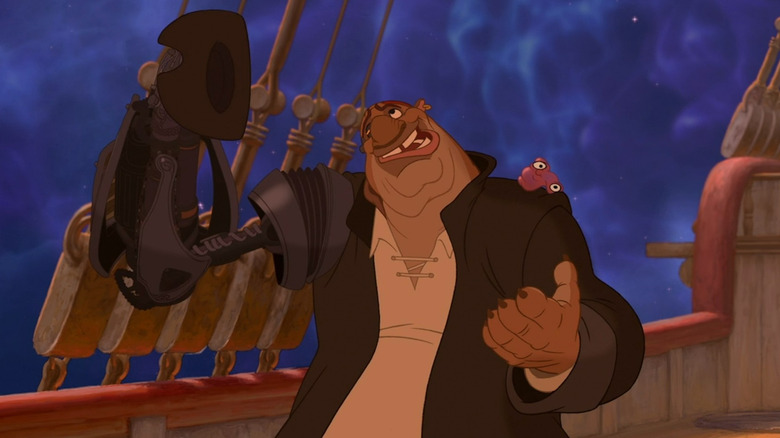Treasure Planet's Animation Was Even More 3D Than It Seems
The early 2000s were a weird time for everyone — Disney included. Like an exhausted millennial desperately rephrasing their resume, Walt Disney Animation Studios was eager to latch onto anything that would permit the company a new lease on life. For context, the Disney Renaissance, which began with "The Little Mermaid" in 1989 and shuttered its majestic doors with "Tarzan" in 1999, was over and the studio wanted to prove it could create stories that were more than musically charged fantasies. What's more, Disney also wanted to explore more computer-generated imagery or, as it's better known, CGI. Throw in an increasingly voracious audience with a highly specific hunger for science-fiction and, well, two and two makes four.
Look, this is a gross exaggeration of how Disney functioned in the early 2000s. It seems like the company was working with a strict "throw everything at the wall and see what sticks" mentality. Nothing else explains the sheer quantity of animation that Disney churned out in what some have dubbed the Age of Frenzied Success. That being said, three of the earliest projects in this period were science-fiction and one of them changed how Disney approached CGI animation forever.
Enter "Treasure Planet," a futuristic retelling of Robert Louis Stevenson's classic novel "Treasure Island." Starring the voice talent of celebrities such as Joseph Gordon-Levitt, Emma Thompson, and Martin Short, "Treasure Planet" is as much a tale of swashbuckling as it is of creating a found family. While most nostalgic rewatches of John Musker and Ron Clement's joint creation are fueled by a universal attraction to Jim Hawkins (Gordon-Levitt), you should probably take a chance to appreciate scenery because there's a lot more going on with the CGI than you might think.
Treasure Planet sets were fully rendered from all angles
Let's get the obvious out of the way first: A drawing is two dimensional. It's got an X axis and a Y axis but, much like the sixth generation of "Pokémon," there's no Z in sight. Functionally, that means that every frame of a 2D animation project is planned ahead of time so that the renders will all match up. It also means that the camera angle is factored into each hand-drawn frame from the very beginning. In a 2002 interview with 70mm, Roy Conli — a producer on "Treasure Planet" — shared how that just wasn't enough freedom for John Musker or Ron Clement:
"We were able to employ a technology that was developed during 'Tarzan' called Deep Canvas, which allowed us to build sets in the computer, three-dimensionally. It's almost as if you're going in on a live-action set, and stroke-for-stroke, painting it as if you're painting a regular background. Only what you're utilizing is a digital paint brush that's being controlled by a stylist and a digital paint palette."
Conli went on to explain that, unlike "Tarzan," where the digital set painting was done on a "shot based" system where detail was only added where it was needed, the "Treasure Planet" sets were painted in their entirety, from every angle, so that camera experimentation could occur during production. Now think back to how many CGI sets were featured in "Treasure Planet." Montressor. Crescentia. Literal space, brimming with space whales (oh, that's where James Cameron got them from). Treasure freaking Planet itself? All CGI. Does that mean that a ton of effort went unseen? Absolutely. Is it still fascinating to think about? 100 percent yes.
Disney's first hybrid animation character
While perhaps not as globally impressive, another interesting way that "Treasure Planet" featured a new use for CGI is in the character models. Please don't misunderstand, "Treasure Planet" by no means originated the idea of 3D characters in a 2D space (Disney didn't even start that particular trend with their earlier sci-fi adventure, "Atlantis: The Lost Empire"), but "Treasure Planet" was the first Disney film to create a character that was both traditional 2D cel animation and 3D CGI. That's right folks, we're talking about the turncoat pirate captain himself, John Silver. Roy Conli described the pirate as the first "hybrid character," saying:
"Being a cyborg, he's half-man and half-machine. His machine half has been animated in a computer with the latest state-of-the-art, 3D animation software. And then his human half, or his biological half, is traditionally hand drawn by probably the greatest living Disney animator today, Glen Keane."
In a way, John Silver is the mascot for the sort of barriers that "Treasure Planet" faced during production. Conli admitted that blending the two mediums, 2D and 3D, was the primary focus of the film's development stage. The technology simply didn't exist, so Disney had to create it themselves. And create it they did. Despite "Treasure Planet" bombing at the box office, it still owns a cherished place in many fans' hearts. What's more, there's just no way that the work done behind the scenes on John Musker and Ron Clement's brain baby didn't go on to influence how Walt Disney Animation Studios would use CGI for years to come.


